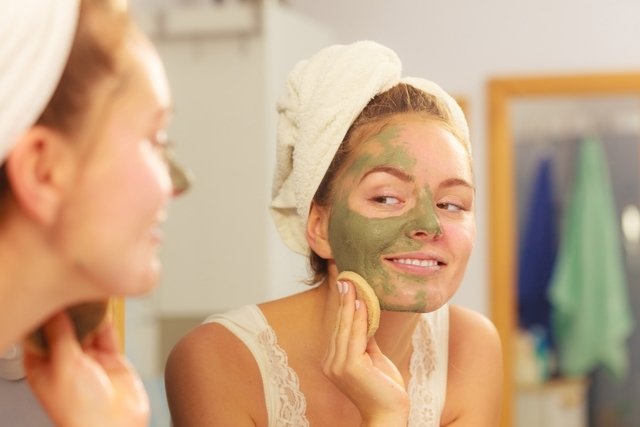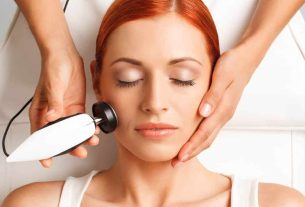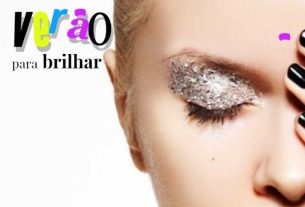Green clay, also known as montmorillonite, can be applied to the face or hair and is a type of clay used to treat wrinkles, spider veins, oily skin, blemishes, weak hair and back pain, for example.
There are different types of clay, with green clay being one of the most used for medicinal and aesthetic purposes, known as clay therapy. Understand better what clay therapy is and how it is done.
If you have any doubts about the use of green clay, it is recommended to consult a dermatologist, who can advise on the care you should take with any skin type and the most suitable products for each skin type.

What is it for
Green clay is recommended for:
- Lighten the skin, removing blemishes;
- Reduce wrinkles, cellulite and sagging skin;
- Eliminate blood vessels and small varicose veins in the skin;
- Strengthen and stimulate hair growth;
- Assist in the healing of wounds and diaper rash;
- Maintain skin tan;
- Relieve pain in case of bursitis, low back pain or headache;
Due to its ability to regulate skin oil, green clay is especially recommended for oily and/or acne-prone skin. Learn about the main skin types and how to care for them.
Benefits of green clay
The main benefits of green clay are:
1. Regulates skin oil
Green clay has sebum-regulating activity, helping to control oil production by the skin glands, due to its composition.
2. Promotes healing
Due to the presence of aluminum and zinc in its composition, green clay has healing properties. It can be used in combination with white clay to enhance its healing effects. Also discover the benefits of white clay.
3. Helps keep skin firm
The green clay contains minerals such as silicon, manganese and magnesium in its composition, which promote skin health and collagen production, helping to keep the skin firm. See tips to avoid sagging body.
4. Acts as an exfoliant
Green clay has a gentle exfoliating action when applied to the skin, which helps remove the layer of dead skin cells and eliminate blemishes.
5. Stimulates blood circulation
Due to its composition, green clay has the ability to insulate the skin, conserving heat and stimulating the relaxation of blood vessels, which improves blood circulation and favors the elimination of toxic substances from the skin.
How to use
Green clay can be used on the hair, face or other parts of the body, and can be applied as a facial mask, paste or compress prepared by adding water to the clay powder. Depending on its indication, it can also be mixed with pulps or extracts of specific fruits and clays of other colors to enhance its effects.
Green clay can be used as follows, according to its instructions:
- Strengthen hair and stimulate growth: mix the green clay paste with apple cider vinegar and apply it all over the scalp 2 to 3 times a week;
- Lighten skin blemishes: Mix the green clay in a small amount of water until a homogeneous paste is formed. Apply the paste to the stain and leave it to act for 90 minutes, daily. To remove the paste, wash the skin under running water;
- Smooth wrinkles on the face: Apply a mixture of green clay, tomato extract and honey to wrinkles, leaving it to act for 60 minutes. Then, remove with a cotton pad dampened in water. Repeat the application daily;
- Eliminate blood vessels: Prepare the green clay with apple cider vinegar and apply it to the affected part of the body, leaving it to act for 90 minutes. Repeat the application daily and, after the spider veins disappear on the skin, continue for another 15 days;
- Back pain: Apply a thick layer of heated green clay paste to the affected part of the spine. Leave to act for 90 minutes and remove using warm ginger water. Repeat the application until you notice pain relief;
- Heal diaper rash: Prepare the green clay with warm or cold tea from the cipó azougue plant. Apply to the affected skin, leave to act for 45 to 60 minutes and remove with tea or cold water. Repeat the application until you notice pain relief.
Furthermore, green clay can also be used in the form of compresses to relieve pain in case of headache or bursitis, for example.
Cautions when using
Children, pregnant women and the elderly have more delicate skin and, therefore, should only use green clay under the guidance of a dermatologist. In case of illnesses such as diabetes, care must be taken due to the risk of skin damage. Furthermore, it is not recommended to apply green clay directly to open wounds. In this case, the paste should only be used around the wound to aid healing.

Sign up for our newsletter and stay up to date with exclusive news
that can transform your routine!
Warning: Undefined array key "title" in /home/storelat/public_html/wp-content/plugins/link-whisper-premium/templates/frontend/related-posts.php on line 12
Warning: Undefined array key "title_tag" in /home/storelat/public_html/wp-content/plugins/link-whisper-premium/templates/frontend/related-posts.php on line 13



